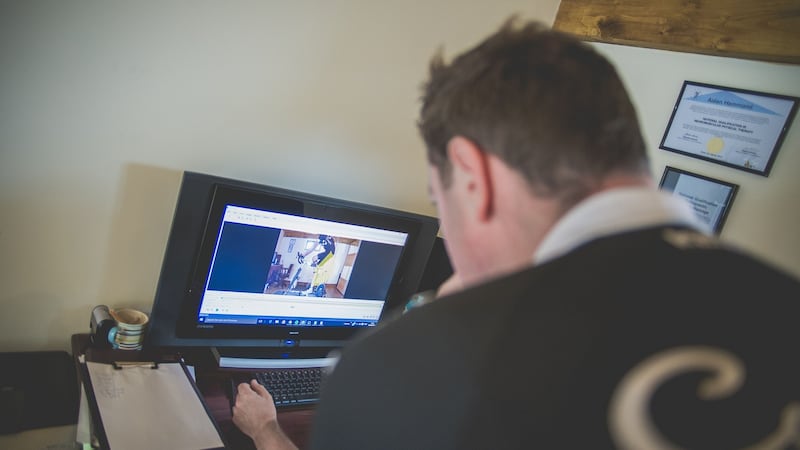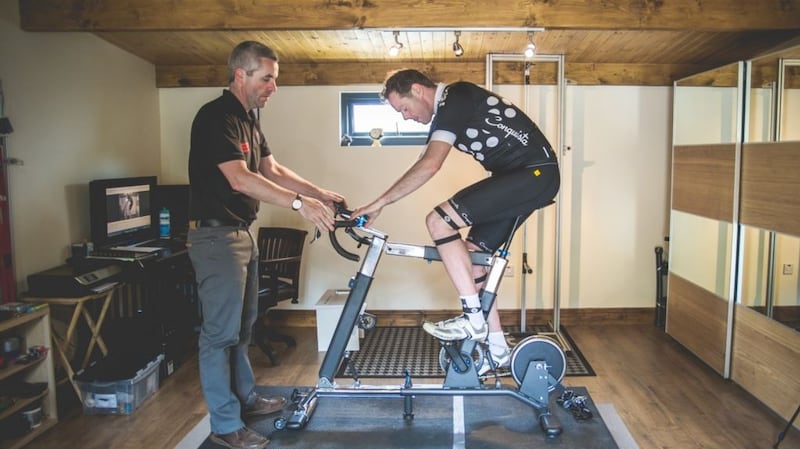
We’re watching back the first video clip of me riding my stationary bicycle and straightaway the problem appears to be that slight hunchback. Turns out this may be the least of my problems, maybe not a problem at all, as long as my overall riding position isn’t too far off.
Well, turns out it is, and in more ways than one – which even for the strictly pleasure and non-competitive cyclist such as myself can add up to a bunch of more telling problems, including long-term injury, loss of power and efficiency, and that often nagging feeling that riding up the Wicklow Gap is somehow getting longer and harder every year.
Turns out too the most important thing isn't necessarily what looks or feels right when riding a bike, more what measures right: which is why I'm in the company of Aidan Hammond who, over the past 20 years, has earned a reputation as one of the most experienced bike fitters in Ireland.
It’s easy to understand why professional cyclists go to painstaking detail to ensure their bike is the right fit, from the height of the saddle to the exact angle of the handlebars and pedals and toe-clips: just because you ride for pleasure or fun doesn’t mean these measurements aren’t just as critical, the difference between right and wrong just as telling. Even if not as noticeable as that slight hunchback.
You average about 5,000 pedal strokes for every hour of cycling
Hammond runs Bike Fitting Ireland from the side studio built next to his home in Kilmacanogue in Wicklow and measures all levels of riders from aspiring professionals to near beginners (he does about 1,000 bike fittings every year). "What all riders share is the fact you average about 5,000 pedal strokes for every hour of cycling," Hammond tells me. "So whether that's over two hours or four hours or eight hours, that all adds up.
“There are also just three contact points on a bike, the saddle, stem and bars and then pedal and shoes, and all three points are very adjustable. If one or two of these contact points are off then that can cause problems, an injury, or over-use of certain muscles or tendons. It’s not just that there’s no such thing as one-bike-fits-all. Even with a suitable frame size, longer legs and shorter arms and overall flexibility can also influence riding position.
“Knee pain and lower back pain would usually be the main issues, followed then by neck and shoulder pain, but there can also be hand numbness, sore feet and saddle soreness, all related to incorrect cycling positions.”
It also helps that Hammond has considerable practice in what he teaches: he was one of the top amateur racers in his day, winning several stage race titles and National Time Trial medals, coming from an esteemed cycling family, and also marrying into one. He’s also a qualified physical therapist, and Level 3 Cycling Ireland Coach, so there’s very little he doesn’t know about proper cycling positions.
I’m here for the standard bike fit, which takes an hour and a half (Hammond also provides an advanced bike fit, plus a bike fit with bioracer aero analysis). Since first taking to road cycling about 15 years ago I’ve made various adjustments to those three contact points – saddle, handlebars and pedals – but never with the sort of expertise and computer and video software that Hammond has at hand.
The bike fitting – a nine-step process in all – actually starts on the treatment table, and a quick run through any previous cycling injuries or otherwise, before an all-round test of flexibility; okay on that front. He also measures foot and gait analysis for correct cleat (pedal) set-up, and checks knee alignment and hip balancing. It’s not always the bike that isn’t measuring up correctly.
Hammond then positions my bike on the stationary turbo trainer (removing the back wheel, etc) where the closer analysis begins but doesn’t end. He marks up my knees, hips and ankles with sensors that respond to cycling specific software that tracks every movement and angle of each pedal stroke, including the back, torso, knees, ankles, hips and arms, which are also recorded on video.
He slips a cover over the saddle, which will measure the exact “pressure points”, and, more importantly, the spread of them on the saddle. Turns out I’m all over the saddle, way more pressure points to the front and side than there should be. It’s all revealed in that first video clip.

“The saddle is definitely off, not just too high, but titling too far forward. That’s impacting the pedal stroke, with 64 per cent to the right, 36 per cent to the left. There is 97 per cent of weight towards the back of the saddle, a recipe for saddle soreness, really. And the leg is essentially too straight, an angle of 163 degrees, when something more like 153 degrees is ideal.”
With that the adjustments begin: my saddle comes down 2.5cm, which is quite a bit, actually. My handlebars are dropped too far down, so Hammond brings those up slightly, also dropping the brake grips down a little. The cleat positions and pedal riding angles are all fine, the problem was the measurements above them, which will likely result in some sort of over-use knee injury or strain.
We’re now watching the second video clip of me riding after the adjustments are made, and straightaway the hunchback isn’t quite as bad. Turns out that’s probably more habit too, partly blamed perhaps on being hunched over the laptop for the best part of the day. “You shouldn’t really have to think about posture on the bike. If the bike fit is right, then it’s okay to sit whatever feels best, rather than try to force the posture.”

The added bonus is that being in a more comfortable and efficient riding position will invariably make for a safer one, especially those only beginning to venture out onto the more open roads. It normally takes three or four rides for the new adjustments to take effect. Only a week later, on the first gentle ride towards the Wicklow Gap, I feel them straightaway.
Do it yourself
For a basic at-home bike-fitting test: on a stationary bike (either on a turbo trainer or just leaning up against the wall), remove the cleat from the pedal, pedal backwards, and you should be able to touch the top of the pedal with the heel of the cycling shoe; if you can’t reach it, the saddle is likely too high.











